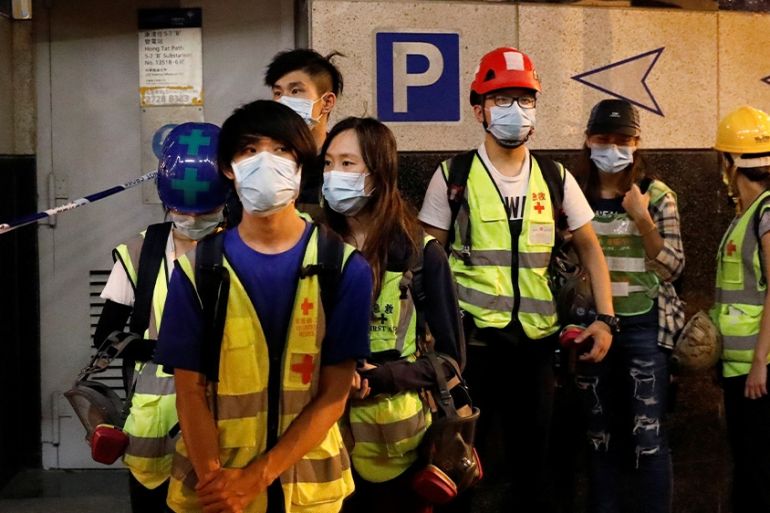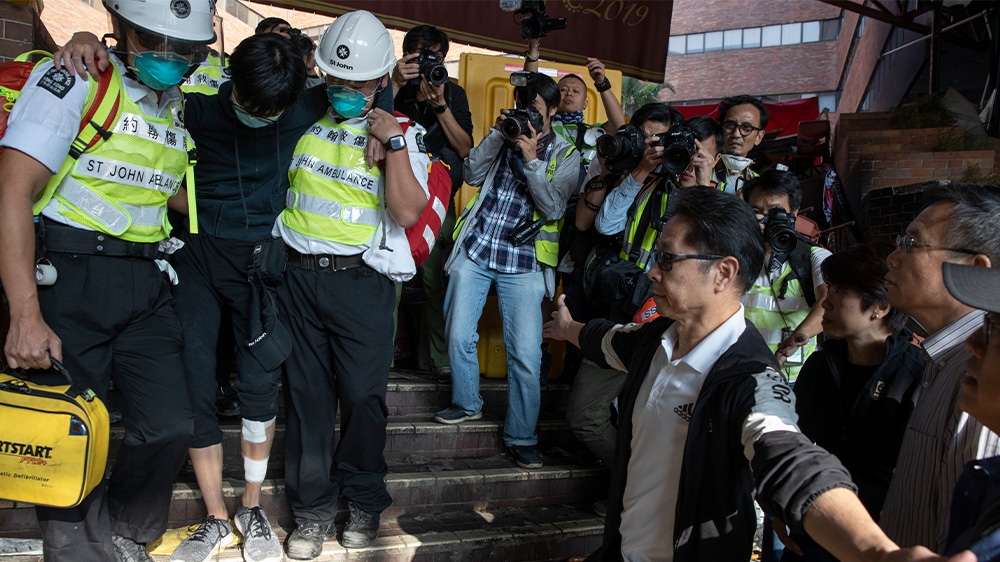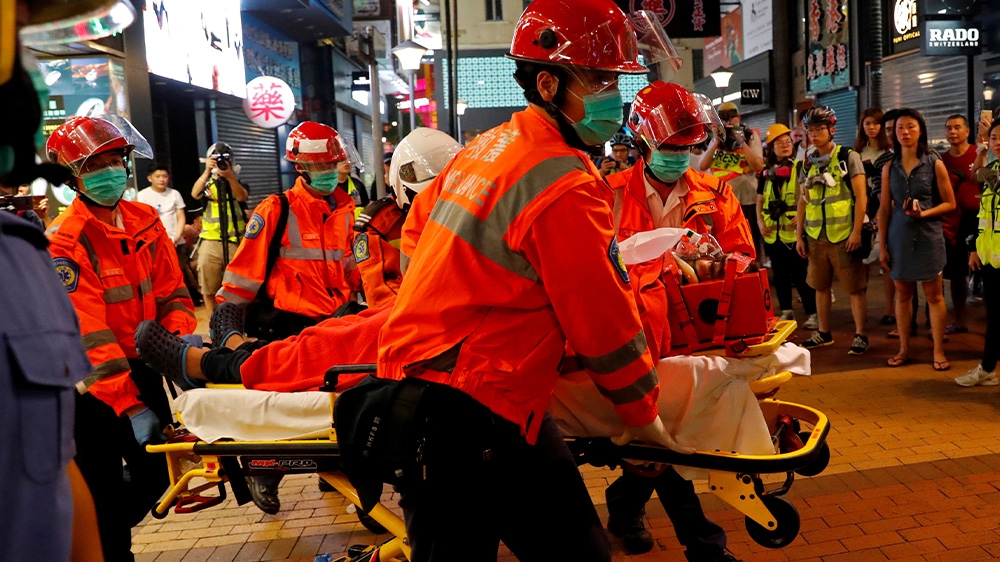Anger after Hong Kong police detain medics providing protest care
Hong Kong’s crackdown on volunteer medics has triggered a rebuke from doctors providing front-line care in protests

Hong Kong, China – Last week, as police laid siege to the Hong Kong Polytechnic University, an image of volunteer medics in high-visibility vests, hands tied behind their backs spread rapidly through social media.
Darren Mann, who has worked as a surgeon in Hong Kong for 25 years and volunteered to treat the injured at the besieged campus managed to leave the premises on 17 November.
Keep reading
list of 1 itemBut as the situation deteriorated, he later discovered that a group of first aid volunteers he had been working with had been detained by police as they attempted to depart.
“What we appreciated in the medical community is that at the violent interface between protesters and police, there was obviously a very high potential for people to be injured,” Mann told Al Jazeera, adding that the role of medics was to provide care to all groups involved in conflict.
“The societal benefit and the human good of having medical aiders providing emergency care for the injured, that’s recognised … That’s the spirit of humanitarianism that we all agree to.”
In the wake of the detentions, Mann published an article in The Lancet – a respected medical journal – arguing the temporary detention of volunteer medics by police was a breach of international humanitarian norms.

The network of first aid staff has played a crucial role in Hong Kong’s protest movement since June when opposition to the government’s plans for a proposed extradition bill to China kicked off. As violence increased and roads were blocked, first responders provided on-the-spot treatment to those unable to get to medical facilities quickly.
But the temporary detention of medics during the siege at the Polytechnic University – the most serious confrontation in nearly six months of unrest – has raised questions about the risks faced by volunteers operating in an increasingly fraught environment.
However, Noam Zamir, assistant professor of law at City University of Hong Kong said international humanitarian law did not apply in Hong Kong, because the situation was not an armed conflict between states or a civil war.
But he also said the circumstances could be judged within the framework of international human rights law, after which Hong Kong’s code of law is closely modelled. “Under human rights law, there is a right to life,” Zamir said. “This is the right that is also enshrined in the Hong Kong Bill of Rights.”
The International Covenant on Civil and Political Rights states that the right to life is protected by law and that “no one should be arbitrarily deprived of life.”
“Hong Kong is one of the examples of good jurisdictions that incorporated many international human rights norms into their domestic legal system,” Zamir said, adding this right did not directly address the issue of the first aiders who helped the protesters, but applied to anyone who required first aid for potentially life-threatening injuries sustained in protest actions.
“If there are wounded people, they are entitled to receive medical treatment,” Zamir said.

In a news conference last week, Hong Kong police said volunteer emergency staff were detained because they lacked medical credentials, citing 12 examples of people wearing first aid gear who were unable to produce medical ID when they were questioned.
“We have no way to identify who is a first aider and how to qualify an individual as a first aider,” Cheuk Hau-yip, Kowloon West Regional Commander said.
“In this sense, I’m very worried about the standard they provide to those in need.”
But Mann, writing in the Lancet, cited five incidents where doctors were detained for more than 24 hours. “The arrest of these personnel is almost unheard of in civilised countries and is incompatible with the compact of humanitarianism,” he wrote.
Instead of encouraging a higher level of medical care, Arisina Ma, president of the Hong Kong Public Doctors’ Association said the detention of volunteers could have the opposite effect – making trained medical professionals less likely to volunteer during demonstrations out of fear that their jobs or medical licences could be imperilled.
“They are prepared for the danger,” Ma said. “But we are not yet prepared to be arrested or to be fired.”
Ma said all healthcare workers who were held during the confrontations at Polytechnic University have been released on bail.
Events at the campus called for a more comprehensive level of medical assistance said B, a nurse by training who preferred to remain anonymous. She arrived at the university on 16 November and stayed until Wednesday last week.
B and two others decided to remain on-site to provide care to the demonstrators even when her team of seven first aid workers heard police would classify the situation as a riot, potentially opening her team up to being charged for aiding the demonstrators. She said about 20 workers with varying skills levels – some full-time nurses and others with basic first aid training were on-site during that period.
The 30-year-old said the mood was sombre; she would get between two and three hours of sleep in designated “safe areas” on campus, usually in the library, huddled with other medics and students for protection.

The injuries B saw were mostly minor, including dislocated body parts and glass cuts. But she heard from others who had remained on campus, including a lone doctor, that some of the wounded had sustained more serious injuries and needed cardiopulmonary resuscitation or CPR.
If she and other trained medical professionals had not decided to take the risk and remain at the university, those inside would not have received sufficient care. “What I don’t want to see as a nurse is for more people to get hurt,” she said.
When B attempted to leave the campus on Wednesday, she was told by officers that any medics, including those with professional qualifications, would be arrested and should surrender.
She was eventually allowed to leave through an exit point with a group of journalists. She said the officer at that cordon saw she was wearing reflective gear labelling her as a nurse and told her not to come back.
On Monday night, a crowd gathered in front of a police line. A small number of protesters were still thought to be inside the university.
Alvin L, 28, who leads a group of 36 first responders, was in the crowd.
He had spent time volunteering on the campuses of the Chinese University – the scene of violent confrontations the week before – and the Polytechnic University and said volunteers would provide help to whoever needed it – protester or police officer.
“We treat it as serious. To us, professionalism kicks in,” he said. “Regardless of if he is a cop or not, we don’t care.”

According to Hong Kong’s Hospital Authority on Monday, 280 people who were injured at the Polytechnic University had been sent to public hospitals.
Since the protests began some 2,615 patients had been treated for injuries, the authority said, but the volunteer medics said some people did not want to seek treatment in public hospitals for fear of being pegged to the protest movement.
Police have also incurred injuries; a media liaison officer was taken to hospital after being shot in the leg by an arrow during the Polytechnic University standoff.
“Police have all along emphasised two fundamental principles: peaceful resolution and flexibility,” the Hong Kong Police Public Relations Branch spokesperson told Al Jazeera. “Police will assist the injured people who have left PolyU to receive treatment in hospital first before further investigation.”
At the Polytechnic University, tear gas, water cannon, and rubber-coated bullets were frequently used by the police, while protesters created their own makeshift weapons including petrol bombs, bows and arrows, and bricks. By Wednesday, the siege appeared to be over.
Mann said the role of front-line first aiders was crucial to ensure on-the-spot treatment for injuries in danger zones.
“I’ve been a surgeon for 35 years, but I could not do a first aider’s job any better than a first aider can because of the basic skills that are needed.”
Ma from the Hong Kong Public Doctors’ Association said the clashes at the university only reinforced the view that medical personnel were here to serve anyone in need of aid.
“We are neutral, we treat anyone,” she said.